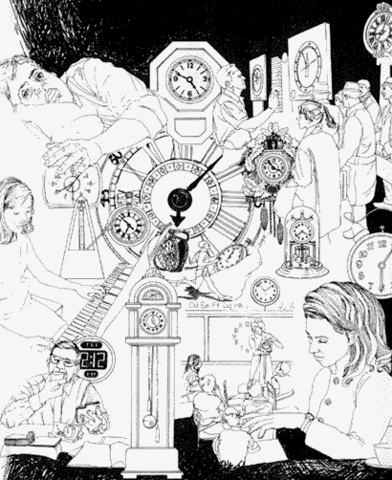A Walk Through Time - A Revolution in Timekeeping
In Europe during most of the Middle Ages (roughly 500 CE to 1500 CE), technological advancement virtually ceased. Sundial styles evolved, but didn't move far from ancient Egyptian principles.
During these times, simple sundials placed above doorways were used to identify midday and four "tides" (important times or periods) of the sunlit day. By the 10th century, several types of pocket sundials were used. One English model even compensated for seasonal changes of the Sun's altitude.

Another advance was the invention of spring-powered clocks between 1500 and 1510 by Peter Henlein of Nuremberg. Replacing the heavy drive weights permitted smaller (and portable) clocks and watches. Although they ran slower as the mainspring unwound, they were popular among wealthy individuals due to their small size and the fact that they could be put on a shelf or table instead of hanging on the wall or being housed in tall cases. These advances in design were precursors to truly accurate timekeeping.
Accurate Mechanical Clocks
In 1656, Christiaan Huygens, a Dutch scientist, made the first pendulum clock, regulated by a mechanism with a "natural" period of oscillation. (Galileo Galilei is credited with inventing the pendulum-clock concept, and he studied the motion of the pendulum as early as 1582. He even sketched out a design for a pendulum clock, but he never actually constructed one before his death in 1642.) Huygens' early pendulum clock had an error of less than 1 minute a day, the first time such accuracy had been achieved. His later refinements reduced his clock's error to less than 10 seconds a day.
Around 1675, Huygens developed the balance wheel and spring assembly, still found in some of today's wristwatches. This improvement allowed portable 17th century watches to keep time to 10 minutes a day. And in London in 1671, William Clement began building clocks with the new "anchor" or "recoil" escapement, a substantial improvement over the verge because it interferes less with the motion of the pendulum.
In 1721, George Graham improved the pendulum clock's accuracy to 1 second per day by compensating for changes in the pendulum's length due to temperature variations. John Harrison, a carpenter and self-taught clock-maker, refined Graham's temperature compensation techniques and developed new methods for reducing friction. By 1761, he had built a marine chronometer with a spring and balance wheel escapement that won the British government's 1714 prize (worth more than $10,000,000 in today's currency) for a means of determining longitude to within one-half degree after a voyage to the West Indies. It kept time on board a rolling ship to about one-fifth of a second a day, nearly as well as a pendulum clock could do on land, and 10 times better than required to win the prize.
Over the next century, refinements led in 1889 to Siegmund Riefler's clock with a nearly free pendulum, which attained an accuracy of a hundredth of a second a day and became the standard in many astronomical observatories. A true free-pendulum principle was introduced by R.J. Rudd about 1898, stimulating development of several free-pendulum clocks. One of the most famous, the W.H. Shortt clock, was demonstrated in 1921. The Shortt clock almost immediately replaced Riefler's clock as a supreme timekeeper in many observatories. This clock contained two pendulums, one a slave and the other a master. The slave pendulum gave the master pendulum the gentle pushes needed to maintain its motion, and also drove the clock's hands. This allowed the master pendulum to remain free from mechanical tasks that would disturb its regularity.
Quartz Clocks
The performance of the Shortt clock was overtaken as quartz crystal oscillators and clocks, developed in the 1920s and onward, eventually improved timekeeping performance far beyond that achieved using pendulum and balance-wheel escapements.
Quartz clock operation is based on the piezoelectric property of quartz crystals. If you apply an electric field to the crystal, it changes its shape, and if you squeeze it or bend it, it generates an electric field. When put in a suitable electronic circuit, this interaction between mechanical stress and electric field causes the crystal to vibrate and generate an electric signal of relatively constant frequency that can be used to operate an electronic clock display.
Quartz crystal clocks were better because they had no gears or escapements to disturb their regular frequency. Even so, they still relied on a mechanical vibration whose frequency depended critically on the crystal's size, shape and temperature. Thus, no two crystals can be exactly alike, with just the same frequency. Such quartz clocks and watches continue to dominate the market in numbers because their performance is excellent for their price. But the timekeeping performance of quartz clocks has been substantially surpassed by atomic clocks.
Notice of Online Archive: This page is no longer being updated and remains online for informational and historical purposes only. The information is accurate as of 2004. For questions about page contents, please pml-webmaster [at] nist.gov (subject: A%20Walk%20Through%20Time) (contact us).

